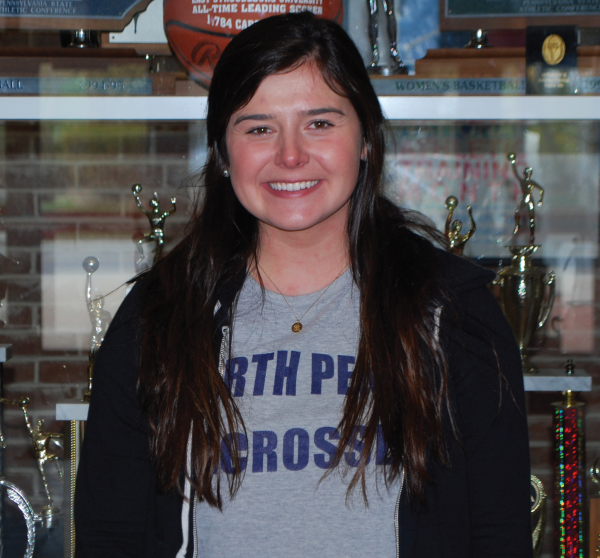

Photo Credit / Ronald Hanaki
By Ronald Hanaki
Sports Editor
When starting goalkeeper Jessica Maxwell from women’s lacrosse went down to injury, the team needed someone to fill in as goalkeeper. Normally a midfielder, Emily Fitzsimmons did not hesitate to step into the unfamiliar role of goalkeeper. She simply said, “The team needed me.”
Kaitlynn Wiltraut, co-captain of the women’s lacrosse team, watched Fitzsimmons work to learn the new position throughout the course of the season. Wiltraut had this to say about her teammate. “Emily is willing to put forth a lot of effort. She’s working hard, and she’s getting a lot better,” said Wiltraut.
Fitzsimmons would find her footing as the team’s new goalkeeper, and the lacrosse team went on to finish the season a respectable 8-8.
Whether on or off the field, the enterprising Fitzsimmons is not afraid of taking on new challenges. Come the fall, Fitzsimmons will be issuing a “Water Challenge” to ESU’s faculty. So who is this wonder woman?
Fitzsimmons is a sophomore psychology major with a concentration in counseling. She began playing lacrosse in the third grade because her father played in high school.
As a promising high school lacrosse prospect, Fitzsimmons would be recruited by ESU. An overnight stay at ESU would seal her decision to commit to ESU.
“I loved the team. ESU was my first choice,” said Fitzsimmons.
A bright student off the field, Fitzsimmons as a freshman caught the eye of psychology professor Dr. John Chang, who recruited Fitzsimmons to become part of his research team.
Fitzsimmons was excited to be part of Dr. Chang’s research team. She said, “I was asked [by Dr. Chang] to be on the research team, and it has really opened doors for me!”
Fitzsimmons continued, “It’s been such a great experience. I’m learning a lot, and it’s well worth it.”
As for balancing academics and athletics, Fitzsimmons said, “It’s tough, and it’s getting tougher. This semester was hard, but as long as you manage your time well, it’s not terrible.”
Dr. Chang had this to say about Fitzsimmons. “Emily is a great person and a nice person. Every parent should have an Emily Fitzsimmons in their household.”
Dr. Chang added, “As a scholar-athlete, Emily has to balance the life of a researcher. Not only is she taking five classes, but she has her [lacrosse] team and her athletic responsibilities.”
“But then she has another academic class that is not required. Basically, she is volunteering her time every week, so she really has a lot of responsibilities to manage. That is a nice example of the quality of student that she is,” said Dr. Chang.
It was Dr. Chang who first identified the faculty and health welfare grant as the university has access to that particular grant.
Dr. Chang asked, “What can we do for the money to enhance the health of the faculty at large? There are exercise programs, but no one shows up. So what can we do different?”
Dr. Chang’s team of students went to work and brainstormed ideas. The objective became to study and measure one type of behavior.
The Prochaska and DiClemente model was used to assess an individual’s readiness to accept a healthier change of behavior. That led to the salubrious benefits of drinking water and the eponymous water challenge.
The water challenge will take place over two weeks in September, and it is directed at ESU’s faculty. The challenge is not open to students because the grant only covers faculty.
The design of the study calls for approximately ten flavored water samples to be set up. ESU faculty will be given $10 water bottle infusers.
Infusers can add fruits, vegetables, and herbs to the water. Thus, the faculty will be able to try different flavors and see what they like drinking.
Every day, faculty will be sent reminders of why they should be drinking water. Pamphlets will be sent to the faculty about the health benefits of drinking a substantial amount of water daily.
A survey will be sent before and after the experimental period measuring how many cups of water are being consumed before, during, and after the study and assessing how the faculty feel about the health benefits of drinking water.
The hypothesis is that by drinking more water, there is going to be a correlation that faculty members will feel better and healthier.
Fitzsimmons found grant writing to be difficult. She said, “The form of writing is different – the process of it – being that it was my first time. I didn’t know what grant writing was. It was hard figuring out the right format. It was hard with what I have going on – all the research and how you have to write it.”
Fitzsimmons added, “Undergrads aren’t exposed to grant writing, but Dr. Chang believes that it should be for a career in academics and the sciences. It will open doors that are hard to get open.”
Fitzsimmons would persevere and was given the honor of presenting the team’s research at ESU’s Student Research & Creative Activity Symposium on April 23.
Fitzsimmons was also recently honored for her work with SAAC (Student-Athlete Advisory Committee).
SAAC works to raise money and awareness for organizations like the Make-A-Wish Foundation and Head Start.
Next season, Fitzsimmons will return to the lacrosse team as a midfielder. She wants the team to beat Millersville as that is always a big rivalry.
Email Ronald at:
rhanaki@live.esu.edu
